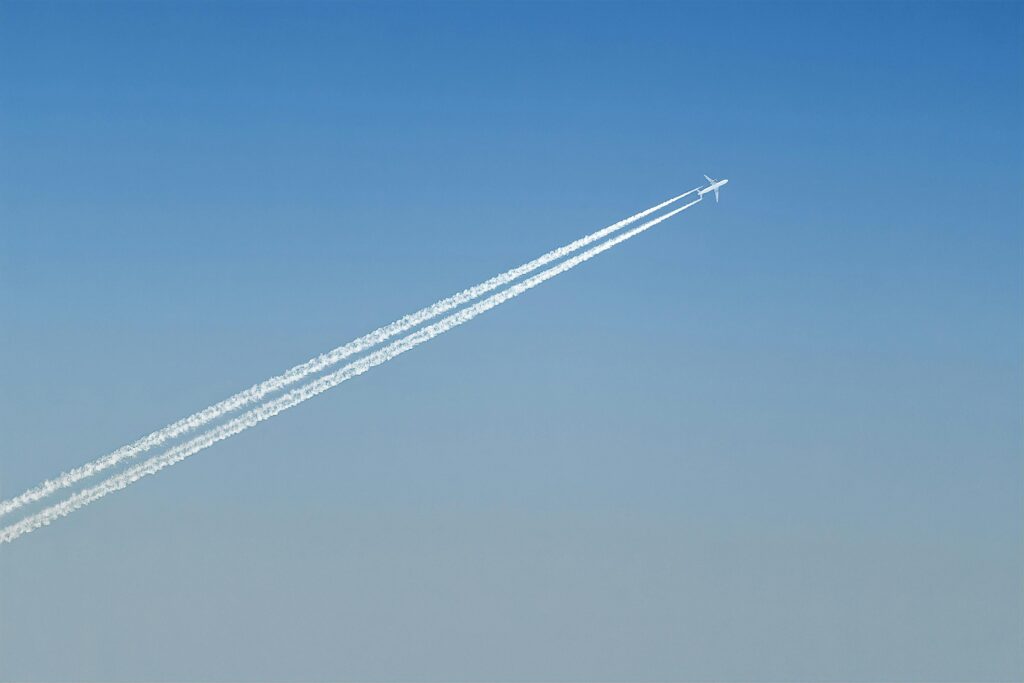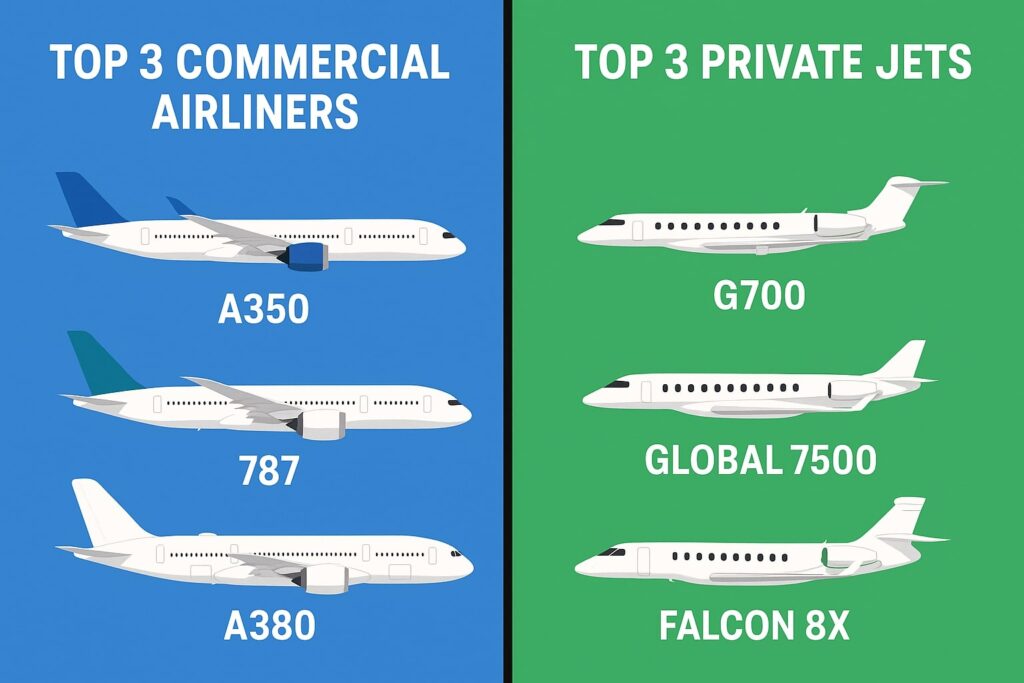Many travelers wonder how long can a plane fly without refueling – essentially, the maximum time or distance an aircraft can stay airborne on one load of fuel. This question matters for route planning (can you fly long-haul routes nonstop or will you need layovers?), fuel efficiency (airlines strive to minimize stops and fuel costs), and aircraft design (manufacturers engineer jets with greater range and better fuel economy).
The answer isn’t one-size-fits-all: it varies widely by aircraft type, from small propeller planes to giant long-haul airliners. In this article, we’ll explore what “without refueling” means, the factors that affect range, and examples of commercial airliners and private jets to see how far can a plane fly without refueling in different scenarios.

What Does “Without Refueling” Mean in Aviation?
In-flight refueling (seen here as a KC-135 tanker tops up an F-16 fighter) is a practice used in military aviation to extend range. However, in civilian aviation “without refueling” means a plane takes off and lands without stopping to add fuel along the way. In other words, the aircraft carries all the fuel it needs for the entire flight from departure to destination. Commercial airlines do not perform mid-air refueling – that’s only done in military operations or special research flights. So when we talk about a plane flying without refueling, we usually mean a non-stop flight with no intermediate landings. The limit of such a flight is essentially the plane’s maximum range, which is how far it can fly on a full tank under certain conditions. (Notably, a military aircraft can in theory stay aloft for days with aerial refueling, but for passenger planes and private jets, “without refueling” just refers to one continuous flight on its own fuel.)
✍️ Pro Tip: Commercial passenger planes never refuel mid-air. If your flight is marked “non-stop,” it means the aircraft is carrying all fuel it needs from takeoff to landing—with reserves.
Factors That Influence How Long a Plane Can Fly
There are several key variables that determine an aircraft’s maximum non-stop range (i.e. how long can planes fly without refueling). These factors include:
- ✈️ Aircraft Type & Design: Different planes are built for different missions. Larger long-haul airliners (like a Boeing 787 or Airbus A350) are designed with huge fuel tanks and efficient engines to fly ultra-long distances, whereas a small regional jet or propeller plane has a limited range. The aerodynamics and engine technology also matter – a more efficient wing and engine will burn less fuel per hour, extending range.
- 🛢️ Fuel Capacity: Quite simply, the more fuel a plane can carry, the farther it can go. Aircraft have a maximum fuel capacity in their wings and tanks. For example, an Boeing 747 can hold tens of thousands of gallons of jet fuel, enabling very long flights. However, there’s a trade-off: carrying more fuel adds weight.
- ⚖️ Payload & Weight: The payload is the weight of passengers, cargo, and baggage. A plane flying at maximum capacity (full of people and cargo) is heavier, which means it burns fuel faster. If an aircraft is lighter (say it’s a ferry flight with no passengers, or it’s not carrying much cargo), it can potentially fly farther on the same fuel. Airlines sometimes limit passenger count or cargo on extremely long routes to reduce weight and extend range.
- 🌬️ Weather Conditions: Wind and weather play a huge role. A strong tailwind (wind blowing in the same direction as the aircraft’s travel) can push the plane and effectively increase its range, while a headwind (wind blowing against the direction of travel) can slow the plane and increase fuel burn. For instance, flights traveling eastward (with the jet stream) often are faster and use less fuel than westward flights. Severe weather can force detours or altitude changes that also impact fuel usage. If weather conditions cause a flight to miss its connection or divert, passengers may be entitled to missed connection compensation.
- 🛰️ Air Traffic Control & Route: Air traffic control constraints and flight routing can influence distance. The most direct great-circle route is usually optimal, but sometimes planes can’t fly the absolute straight line – they might detour around storms, avoid restricted airspace, or follow given air traffic corridors. If a plane has to enter holding patterns (circling awaiting clearance to land) or take a longer path, that uses extra fuel. All of these routing factors can shorten the effective range compared to ideal conditions.
- 🧭 Altitude and Speed: Aircraft are most fuel-efficient at high cruise altitudes and at an optimal speed (not too fast or slow). If a plane cannot climb to its usual altitude (due to traffic or turbulence) or has to fly faster (to make up time), it will burn more fuel. Conversely, flying at the optimal cruise altitude with a steady, economical throttle setting maximizes how long it can stay up. Pilots and flight computers carefully manage this to stretch range on long flights.
- 🔐 Reserves and Regulations: It’s important to note that planes never plan to use 100% of their fuel just to reach the destination. Aviation rules require carrying reserve fuel (for holding patterns, potential diversions to alternate airports, and safety margins). So the practical range is a bit less than the absolute maximum the plane could physically fly. For extremely long routes, sometimes an aircraft can technically make the distance but isn’t allowed to attempt it if there’s not enough cushion for reserves. If your aircraft has to land at an alternate airport due to fuel regulations, your rights under EU Regulation 261/2004 for diverted flights may apply.
All these factors combined determine how long can an airplane fly without refueling. In planning any flight, pilots and dispatchers consider the aircraft’s capabilities and the expected conditions to ensure the plane can safely make it to its destination with fuel to spare.
In some cases, diversions or holding patterns due to weather or traffic congestion can also lead to flight delays. If this happens, you might be entitled to flight delay compensation under EU261.
How Far Can Different Types of Aircraft Fly Without Refueling?

The range “without refueling” varies greatly between different categories of aircraft. To answer how far can a plane fly without refueling, it’s useful to compare examples of commercial airliners versus private jets. Below, we look at some well-known models in each category and their approximate maximum ranges:
Commercial Aircraft
Modern commercial airliners are built for efficiency and long-haul performance. When asking how long can a commercial plane fly without refueling, the answer depends on the model – but some of today’s jetliners can stay airborne 15 hours or more, covering distances that span halfway around the globe. For instance, certain variants are capable of ultra-long routes like New York to Hong Kong nonstop. Here’s a look at a few examples of popular airliners and their maximum ranges:
| Aircraft | Max Range (km) | Typical Usage |
| Airbus A380 | ~15,000 km | Long-haul routes (global) |
| Boeing 787 Dreamliner | ~14,000 km | Ultra-long-haul flights |
| Boeing 737 | ~5,500 km | Short/medium-haul flights |
| Airbus A350-900ULR | ~17,960 km | Longest commercial range |
| Boeing 737-800 | ~5,665 km | Short/medium-haul flights |
Max ranges are approximate and assume optimal conditions. In the table above, “long-haul” refers to intercontinental flights (typically 10+ hours), whereas “short/medium-haul” are regional flights of a few hours. You can see the huge difference in capability: a large wide-body like the Airbus A380 or Boeing 787 can fly roughly 14–15 thousand kilometers nonstop (on the order of 15 hours flight time), while a smaller Boeing 737 single-aisle jet manages around 5–6 thousand km (about 6–7 hours) before needing fuel. Notably, the Airbus A350-900 ULR (Ultra Long Range) is currently the champion of commercial flying distance – with nearly 18,000 km, it was specifically designed for the world’s longest routes. Airlines like Singapore Airlines use the A350-900ULR for marathon flights such as Singapore to New York (~15,300 km), which last almost 19 hours in the air. Such aircraft have extra fuel capacity and optimized aerodynamics to make these nonstop journeys possible.
Private Jets
Private jets come in many sizes, but the high-end models are engineered for long-range so that VIP travelers can fly far without stopping. Many people ask how far can a private jet fly without refueling or how long can a private jet fly without refueling – and the answer varies by jet size and design. Smaller light jets might only fly a few hours between stops, but larger business jets can rival airliners in range. The most capable private jets can cross oceans and continents nonstop, enabling routes like Los Angeles to Tokyo or London to Singapore without refuel. Here are some top examples:
| Aircraft | Max Range (km) | Typical Usage |
| Gulfstream G700 | ~13,890 km | Ultra-long-range VIP travel |
| Bombardier Global 7500 | ~14,260 km | Ultra-long-range intercontinental |
| Dassault Falcon 8X | ~12,000 km | Long-range executive travel |
| Gulfstream G550 | ~12,500 km | Long-range corporate missions |
| Bombardier Global 6000 | ~11,100 km | International business travel |
Larger business jets like the Gulfstream and Global series are built to fly 10+ hours nonstop, which translates to roughly 9,000–15,000 km depending on the model. For example, a Gulfstream G700 can travel about 13,900 km, allowing a flight from New York to Dubai or Sydney to Los Angeles in one hop. These jets are equipped with advanced engines and often carry fewer passengers, which helps extend their range. As shown above, the Global 7500 can exceed 14,000 km – currently one of the longest ranges in private aviation. In practical use, a private jet might rarely need to use its full range, but having that capability means the owners can fly point-to-point virtually anywhere in the world with only one fuel stop (or none at all). In summary, the top private jets can fly for around 12–15 hours nonstop, whereas smaller private planes may need refueling after just 3–4 hours.
📋 Ultra-Long Haul Flight Essentials Checklist
✅ Compression socks
✅ Noise-cancelling headphones
✅ Power bank
✅ Refillable water bottle
✅ Eye mask & neck pillow
✅ Seat upgrade (if possible)
Conclusion
How long can planes fly without refueling depends on the aircraft type and flight conditions. While small planes fly just a few hours, long-range airliners and private jets can exceed 15–18 hours nonstop. Aircraft design, weight, weather, and route all influence range. With modern engineering, non-stop global travel is now more efficient and accessible than ever.
FAQ
The record for the longest non-stop flight is over 23 hours, set by a Boeing 777-200LR flying ~21,600 km. Today’s longest scheduled flights, like Singapore to New York, last around 18–19 hours.
Yes, some modern jets like the Airbus A350-900ULR can fly close to 20 hours. Qantas’ upcoming Project Sunrise flights from Sydney to London are expected to reach that duration.
If a plane runs out of fuel at cruising altitude, it can glide for about 15–20 minutes or up to 150 km, depending on altitude and aircraft type.
The engines shut down, and the plane becomes a glider. Pilots attempt an emergency landing using backup systems and available glide range. Such incidents are rare.
